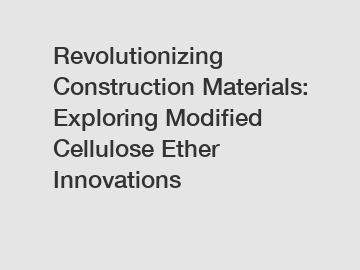Revolutionizing Construction Materials: Exploring Modified Cellulose Ether Innovations
Revolutionizing Construction Materials: Exploring Modified Cellulose Ether Innovations.
The construction industry is constantly evolving, seeking new materials and technologies to enhance the durability, efficiency, and sustainability of buildings. One such innovation that has gained significant attention in recent years is the use of modified cellulose ether in construction materials. This article aims to explore the revolutionary potential of these innovations and their impact on the construction industry.
Enhancing Performance with Cellulose Ether.

Cellulose ether is derived from natural cellulose, a major component of plants. Through modification processes, cellulose ether is created, which exhibits unique properties such as water retention, thickening ability, film-forming capacity, adhesive qualities, and improved workability. These properties make cellulose ether an excellent candidate for enhancing the performance of various construction materials.
Improved Concrete Additives.
One area where modified cellulose ether has shown its potential is in concrete production. By incorporating cellulose ether-based additives into the concrete mixture, several beneficial effects can be achieved. Firstly, it significantly improves the workability of concrete, allowing easier placement and compaction. This saves time and labor costs during construction.
Moreover, modified cellulose ether exhibits water retention properties, which helps to mitigate water loss from concrete during the curing process. This results in reduced shrinkage and cracking, leading to more durable and long-lasting structures. Additionally, cellulose ether can improve the cohesiveness of concrete, enhancing its overall strength and resistance to various environmental factors.
Enhanced Performance in Mortars and Plasters.
In addition to concrete, modified cellulose ether can also enhance the performance of mortars and plasters. By adding cellulose ether-based additives to these materials, the workability and adhesion properties are improved, enabling easier application and better bonding to various surfaces. This leads to increased efficiency and a reduction in material and labor costs.
Furthermore, the water retention capabilities of cellulose ether enhance the hydration process of cement-based materials, allowing for more thorough curing. This results in improved strength, reduced cracking, and a longer lifespan for buildings.
Sustainable Solutions.
Apart from its functional benefits, modified cellulose ether brings sustainability advantages to the construction industry. As a renewable and biodegradable material, cellulose ether reduces the reliance on fossil-fuel-based additives, contributing to a greener construction process. Additionally, the improved workability of construction materials allows for thinner application layers, reducing the overall material consumption and waste generation.
Conclusion.
The revolutionary potential of modified cellulose ether in construction materials cannot be overstated. Its unique properties enhance the performance of concrete, mortars, and plasters, resulting in improved workability, increased durability, and reduced construction costs. Moreover, the sustainability aspects of cellulose ether contribute to a greener and more sustainable construction industry.
As the construction industry continues to embrace innovation, exploring the use of modified cellulose ether in construction materials is a step towards a more efficient, durable, and environmentally friendly future.
For more information on the applications of modified cellulose ether in construction, please contact us.
For more wholesale detergent grade HPMC, Tiled VAE powder, Hydrophobic redispersible polymer powderinformation, please contact us. We will provide professional answers.


